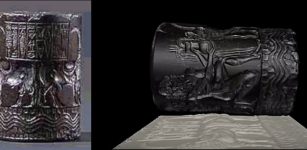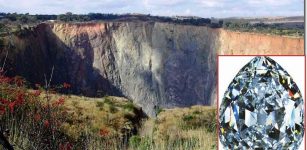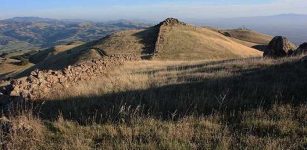America’s Ancient “Mystery Stone” Remains An Unexplained Puzzle
Ellen Lloyd - AncientPages.com - Few people interested in history can resist a true archaeological mystery.
Imagine suddenly finding a strange, dark, odd-looking, egg-shaped stone with unusual carvings and unknown origin. What would you think?
Credit: Public Domain
This is what happened in 1872 when a couple of construction workers dug up a suspicious lump of clay near the shore of Lake Winnipesauke and discovered an artifact that today is known as "New England's Mystery Stone."
Scientists are still trying to determine how the stone was made and for what purpose.
Furthermore, so far, it has been impossible to verify the age of the stone and determine how it was carved. To make it even more interesting, the unknown creator decided to add many inscriptions and strange symbols that are still open to interpretation.
The stone is a type of quartzite, derived from sandstone, or mylonite, a fine-grained, laminated rock formed by the shifting of rock layers along faults. The 4-inch-long, 2 1/2-inch-thick stone is dark and egg-shaped. It includes many carvings like a face, teepee, ear of corn, and geometric figures resembling circles. The rock type is unfamiliar to New Hampshire.
Over the years, many scientists have attempted to unravel the stone's mysterious background. Some, like the American Naturalist, suggested that the stone "commemorates a treaty between two tribes."
New England's Mysterious Stone - Credit: Public Domain
Others believed that the stone was a Celtic or Inuit artifact, but we still do not know who created the Mystery Stone Of New England.
Another curious detail is that holes are bored in both ends of the stone, with different size bits. Each bore is straight, not tapered.
According to an analysis done by state officials in 1994, the holes in both ends of the stones were bored with different size bits. Each bore is straight and not tapered.
"I've seen a number of holes bored in stone with technology that you would associate with prehistoric North America," said Richard Boisvert, state archaeologist. "There's a certain amount of unevenness ... and this hole was extremely regular throughout."
Boisvert suggested the holes were drilled by power tools, perhaps from the 19th or 20th centuries. "What we did not see was variations that would be consistent with something that was several hundred years old," he said.
According to geologist Eugene Boudette, who studied this mysterious stone, "it is a type of quartzite, derived from sandstone, or mylonite, a fine-grained, laminated rock formed by the shifting of rock layers along faults. The rock type was not familiar to New Hampshire, but the state could not be ruled out as the source," Boisvert said to his knowledge, the stone is unique. "That makes it very hard to figure out where it fits," he said.
One problem is that the story of the stone's discovery is fuzzy, he said.
"You couldn't be certain exactly what kind of context it came from. There's a lot of ambiguity there ... it's very difficult to evaluate it," he said. "The context of the discovery is sometimes more important than the item itself."
For example, Boisvert said, if the item had been something used by a fraternal order that has its own secrets and mysteries, "that means the information doesn't get out very well, does it? The information may have been available at one point, but it's really no longer available to us. Who knows?"
For what purpose was the stone created, and what is the meaning of the symbols?
This question remains unanswered. One possibility of solving this ancient is if we could find an artifact with similar symbols and compare the inscriptions. However, we might have to wait a long time before this happens, if ever…
Maybe one day, we will learn the true story of the Mystery Stone of New England, which is undoubtedly one of America's most curious artifacts.
Updated on April 3, 2022
Written by Ellen Lloyd – AncientPages.com
Copyright © AncientPages.com All rights reserved. This material may not be published, broadcast, rewritten or redistributed in whole or part without the express written permission of AncientPages.com
More From Ancient Pages
-
 Jan Hus: Czech Reformer And Bohemian Religious Leader Was Burned At Stake For Heresy
Featured Stories | Dec 17, 2019
Jan Hus: Czech Reformer And Bohemian Religious Leader Was Burned At Stake For Heresy
Featured Stories | Dec 17, 2019 -
 Sharkalishharri Cylinder Seal From The Fifth King Akkad Dynasty
Artifacts | Feb 14, 2016
Sharkalishharri Cylinder Seal From The Fifth King Akkad Dynasty
Artifacts | Feb 14, 2016 -
 Secret Ancient Subterranean Tunnels And Caverns Across America: Who Or What Were Our Ancestors Hiding From?
Ancient Mysteries | Oct 4, 2015
Secret Ancient Subterranean Tunnels And Caverns Across America: Who Or What Were Our Ancestors Hiding From?
Ancient Mysteries | Oct 4, 2015 -
 Is This The World’s Oldest Joke?
Featured Stories | Feb 21, 2014
Is This The World’s Oldest Joke?
Featured Stories | Feb 21, 2014 -
 48,000-Year-Old Tooth That Belonged To Neanderthal Child Found In Northern Italy
Fossils | Sep 19, 2020
48,000-Year-Old Tooth That Belonged To Neanderthal Child Found In Northern Italy
Fossils | Sep 19, 2020 -
 Madagascar Cave Art Hints At Ancient Connections Between Africa And Asia
Featured Stories | Dec 18, 2023
Madagascar Cave Art Hints At Ancient Connections Between Africa And Asia
Featured Stories | Dec 18, 2023 -
 Emerald Production In Eastern Desert Of Roman Egypt – New Evidence
Archaeology | Apr 16, 2021
Emerald Production In Eastern Desert Of Roman Egypt – New Evidence
Archaeology | Apr 16, 2021 -
 King Ferdinand’s Secret Code Deciphered After 500 Years
Archaeology | Feb 14, 2018
King Ferdinand’s Secret Code Deciphered After 500 Years
Archaeology | Feb 14, 2018 -
 On This Day In History: 3,106-Carat Diamond Found – On Jan 25, 1905
News | Jan 25, 2017
On This Day In History: 3,106-Carat Diamond Found – On Jan 25, 1905
News | Jan 25, 2017 -
 Mystery Of Great Wall Of California: An Ancient Unsolved Enigma
Featured Stories | Oct 28, 2015
Mystery Of Great Wall Of California: An Ancient Unsolved Enigma
Featured Stories | Oct 28, 2015 -
 Link Between Changes In Evolution And Climate Discovered
Archaeology | Oct 4, 2022
Link Between Changes In Evolution And Climate Discovered
Archaeology | Oct 4, 2022 -
 Perfectly Preserved Roman Tombs Discovered Near City Of Capua Where Spartacus Trained As Gladiator
Archaeology | Jan 7, 2021
Perfectly Preserved Roman Tombs Discovered Near City Of Capua Where Spartacus Trained As Gladiator
Archaeology | Jan 7, 2021 -
 Mysterious Biblical Canaanites – What Ancient DNA Reveals About Their Fate
Archaeology | Jul 28, 2017
Mysterious Biblical Canaanites – What Ancient DNA Reveals About Their Fate
Archaeology | Jul 28, 2017 -
 What Was The Agriculture Like In Southeast China In The Late Neolithic?
Archaeology | Apr 11, 2022
What Was The Agriculture Like In Southeast China In The Late Neolithic?
Archaeology | Apr 11, 2022 -
 ‘Vampire Of Lugnano’ And Old Beliefs In Witchcraft: Eerie And Weird Discovery In Italy
Archaeology | Oct 13, 2018
‘Vampire Of Lugnano’ And Old Beliefs In Witchcraft: Eerie And Weird Discovery In Italy
Archaeology | Oct 13, 2018 -
 What Can Archaeology Tells Us About Climate Change?
Archaeology | Aug 9, 2021
What Can Archaeology Tells Us About Climate Change?
Archaeology | Aug 9, 2021 -
 Cave 53 In Qumran Region In Judean Desert Reveals More Secrets
Archaeology | Feb 28, 2022
Cave 53 In Qumran Region In Judean Desert Reveals More Secrets
Archaeology | Feb 28, 2022 -
 Lagina Sanctuary Of Goddess Hekate: Archaeologists Found Ceremonial ‘Sacred Road’
Archaeology | Jul 10, 2019
Lagina Sanctuary Of Goddess Hekate: Archaeologists Found Ceremonial ‘Sacred Road’
Archaeology | Jul 10, 2019 -
 Unearthed Ancient Egyptian Tombs At Tel El-Deir Will Rewrite The History Of Damietta – Archaeologists Say
Archaeology | Dec 27, 2022
Unearthed Ancient Egyptian Tombs At Tel El-Deir Will Rewrite The History Of Damietta – Archaeologists Say
Archaeology | Dec 27, 2022 -
 5,000-Year-Old Arminghall Henge In Norwich Reveals Some Of Its Secrets
Archaeology | Dec 20, 2022
5,000-Year-Old Arminghall Henge In Norwich Reveals Some Of Its Secrets
Archaeology | Dec 20, 2022


